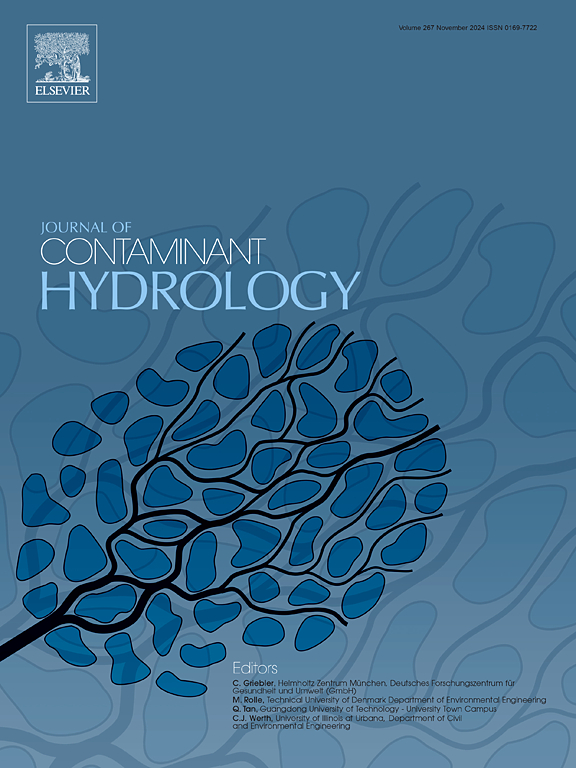Quantification of denitrification rate in shallow groundwater using the single-well, push-pull test technique
IF 3.5
3区 环境科学与生态学
Q2 ENVIRONMENTAL SCIENCES
引用次数: 0
Abstract
Denitrification has been identified as a significant nitrate attenuation process in groundwater systems. Hence, accurate quantification of denitrification rates is consequently important for the better understanding and assessment of nitrate contamination of groundwater systems. There are, however, few studies that have investigated quantification of shallow groundwater denitrification rates using different analytical approaches or assuming different kinetic reaction models. In this study, we assessed different analytical approaches (reactant versus product) and kinetic reaction (zero-order and first-order) models analysing observations from a single-well, push-pull tests to quantify denitrification rates in shallow groundwater at two sites in the Manawatū River catchment, Lower North Island of New Zealand. Shallow groundwater denitrification rates analysed using the measurements of denitrification reactant (nitrate reduction) and zero-order kinetic models were quantified at 0.42–1.07 mg N L−1 h−1 and 0.05–0.12 mg N L−1 h−1 at the Palmerston North (PNR) and Woodville (WDV) sites, respectively. However, using first-order kinetic models, the denitrification rates were quantified at 0.03–0.09 h−1 and 0.002–0.012 h−1 at the PNR and WDV sites, respectively. These denitrification rates based on the measurements of denitrification reactant (nitrate reduction) were quantified significantly higher (6 to 60 times) than the rates estimated using the measurements of denitrification product (nitrous oxide production). However, the denitrification rate quantified based on the nitrate reduction may provide representative value of denitrification characteristics of shallow groundwater systems. This is more so when lacking practical methods to quantify all nitrogen species (i.e., total N, organic N, nitrite, nitrate, ammoniacal N, nitrous oxide, nitric oxide, and nitrogen gas) in a push-pull test. While estimates of denitrification rates also differed depending on the kinetic model used, both a zero-order and a first-order model appear to be valid to analyse and estimate denitrification rate from push-pull tests. However, a discrepancy in estimates of denitrification rates using either reactant or product and using zero- or first-order kinetics models may have implications in assessment of nitrate transport and transformation in groundwater systems. This necessitates further research and analysis for appropriate measurements and representation of spatial and temporal variability in denitrification characteristics of the shallow groundwater system.
用单井推拉试验技术定量测定浅层地下水的反硝化速率。
反硝化作用已被确定为地下水系统中重要的硝酸盐衰减过程。因此,准确量化反硝化速率对于更好地理解和评估地下水系统的硝酸盐污染非常重要。然而,很少有研究使用不同的分析方法或假设不同的动力学反应模型来研究浅层地下水反硝化速率的量化。在这项研究中,我们评估了不同的分析方法(反应物与产物)和动力学反应(零阶和一阶)模型,分析了新西兰下北岛manawati河流域两个地点的单井推拉试验结果,以量化浅层地下水的反硝化速率。在Palmerston North (PNR)和Woodville (WDV)站点,分别在0.42 ~ 1.07 mg N L-1 h-1和0.05 ~ 0.12 mg N L-1 h-1条件下,利用反硝化反应物(硝酸盐还原)测量和零级动力学模型分析了浅层地下水反硝化速率。然而,利用一级动力学模型,PNR和WDV位点的反硝化速率分别为0.03 ~ 0.09 h-1和0.002 ~ 0.012 h-1。这些基于反硝化反应物(硝酸盐还原)测量的反硝化速率比使用反硝化产物(氧化亚氮产量)测量估计的速率要高得多(6至60倍)。然而,基于硝酸盐还原量化的反硝化速率可以提供浅层地下水系统反硝化特性的代表性值。当在推拉试验中缺乏量化所有氮种(即总氮、有机氮、亚硝酸盐、硝酸盐、氨态氮、氧化亚氮、一氧化氮和氮气)的实用方法时,更是如此。虽然反硝化速率的估计也因所使用的动力学模型而异,但零级和一阶模型似乎都可以有效地分析和估计推拉试验的反硝化速率。然而,使用反应物或生成物以及使用零级或一级动力学模型对反硝化速率的估计存在差异,这可能会影响地下水系统中硝酸盐运输和转化的评估。这需要进一步的研究和分析,以适当测量和表示浅层地下水系统反硝化特征的时空变化。
本文章由计算机程序翻译,如有差异,请以英文原文为准。
求助全文
约1分钟内获得全文
求助全文
来源期刊

Journal of contaminant hydrology
环境科学-地球科学综合
CiteScore
6.80
自引率
2.80%
发文量
129
审稿时长
68 days
期刊介绍:
The Journal of Contaminant Hydrology is an international journal publishing scientific articles pertaining to the contamination of subsurface water resources. Emphasis is placed on investigations of the physical, chemical, and biological processes influencing the behavior and fate of organic and inorganic contaminants in the unsaturated (vadose) and saturated (groundwater) zones, as well as at groundwater-surface water interfaces. The ecological impacts of contaminants transported both from and to aquifers are of interest. Articles on contamination of surface water only, without a link to groundwater, are out of the scope. Broad latitude is allowed in identifying contaminants of interest, and include legacy and emerging pollutants, nutrients, nanoparticles, pathogenic microorganisms (e.g., bacteria, viruses, protozoa), microplastics, and various constituents associated with energy production (e.g., methane, carbon dioxide, hydrogen sulfide).
The journal''s scope embraces a wide range of topics including: experimental investigations of contaminant sorption, diffusion, transformation, volatilization and transport in the surface and subsurface; characterization of soil and aquifer properties only as they influence contaminant behavior; development and testing of mathematical models of contaminant behaviour; innovative techniques for restoration of contaminated sites; development of new tools or techniques for monitoring the extent of soil and groundwater contamination; transformation of contaminants in the hyporheic zone; effects of contaminants traversing the hyporheic zone on surface water and groundwater ecosystems; subsurface carbon sequestration and/or turnover; and migration of fluids associated with energy production into groundwater.
 求助内容:
求助内容: 应助结果提醒方式:
应助结果提醒方式:


